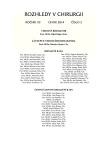The use of acellular biological xenografts in local treatment of Lyell’s syndrome
Authors:
H. Klosová; Z. Němečková Crkvenjaš; L. Petráš; J. Štětinský
Authors‘ workplace:
Popáleninové centrum FN Ostrava, primářka: MUDr. Z. Němečková Crkvenjaš
Published in:
Rozhl. Chir., 2014, roč. 93, č. 2, s. 76-81.
Category:
Case Report
Overview
Lyell’s syndrome, also known as toxic epidermal necrolysis (TEN), is a rare skin disease characterized by a high mortality rate, systemic toxicity and extensive epidermal necrolysis with mucosal erosions. TEN is caused by an allergic autoimmune response, most commonly occurring as a result of an allergic reaction to medication. Our case report describes a nine-year-old boy suffering from Lyell’s syndrome, with 95% of the body surface area affected.
Key words:
Lyell’s syndrome – xenotransplantation
Sources
1. Lyell A. Toxic epidermal necrolysis: an eruption resembling s calding of the skin. Br J Dermatol 1956;68:355–61.
2. Harr T, French LE. Toxic epidermal necrolysis and Stevens-Johnson syndrome. Orphanet J Rare Dis 2010;5:1–12.
3. Lebargy F, Wolkenstein P, Gisselbrecht M, Lange F, Fleury-Feith J, et al. Pulmonary complications in toxic epidermal necrolysis: a prospective clinical study. Intensive Care Med 1997;23: 1237–1244.
4. Garcia Bernal FJ, Torrero V, Regalado J, Ferdinandez Samaniego F, Gabilondo GJ. Lyell syndrome management in a burn unit. Annals of Burns and Fire Disasters 1998;11:217–221
5. Wolkenstein P, Latarjet J, Roujeau JC, Duguet C, Boudeau S, et al. Randomised comparison of thalidomide versus placebo in toxic epidermal necrolysis. Lancet 1998;352:1586–1589.
6. Bachot N, Revuz J, Roujea JC. Intravenous immunoglobulin treatment for Stevens-Johnson syndrome and toxic epidermal necrolysis: a prospective noncomparative study showing no benefit on mortality or progression. Arch Dermatol 2003;139:33–6.
7. Cartotto R, Mayich M, Nickerson D, Gomez M. SCORTEN accurately predicts mortality among toxic epidermal necrolysis patients treated in a burn center. J Burn Care Res 2008; 29:141–6.
8. Bastuji-Garin S, Fouchard N, Bertocchi M, Roujeau JC, Revuz J, Wolkenstein P. SCORTEN: a severity-of-illness score for toxic epidermal necrolysis. J Invest Dermatol 2000;115:149–53.
9. Imahara SD, Holmes JH4th, Heimbach DM, Engrav LE, Honari S, et al. SCORTEN overestimates mortality in the setting of a standardized treatment protocol. J Burn Care Res 2006;27: 270–5.
10. Lipový B, Říhová H, Gregorová N, Suchánek I. Toxická epidermální nekrolýza: přehled možností terapie. Hojení ran 2011; 5:6–12.
11. Šuca H, Tokarik M, Pafčuga I, Zajíček R. Toxická epidermální nekrolýza – naše zkušenosti s celkovou i lokální léčbou. Hojení ran 2011;5:22–24.
12. Zajicek R, Mandys V, Mestak O, Sevcik J, Königova R, et al. Human keratinocyte growth and differentiation on acellular porcine dermal matrix in relation to wound healing potential. ScientificWorldJournal 2012;2012:1–8.
13. Zajíček R, Brož L, Klein L, Bláha J, Königová R, et al. Xe-Derma: nový biologický kryt pro léčbu akutních a chronických ran. Hojení ran 2008; 2:18–27.
Labels
Surgery Orthopaedics Trauma surgeryArticle was published in
Perspectives in Surgery

2014 Issue 2
- Metamizole at a Glance and in Practice – Effective Non-Opioid Analgesic for All Ages
- Metamizole vs. Tramadol in Postoperative Analgesia
- Spasmolytic Effect of Metamizole
Most read in this issue
- Evaluation of safe resection margins in tumours of parenchymatous organs
- Evaluation of safe resection margins in rectal carcinoma
- Evaluation of safe margins in pathology examination in breast oncosurgery
- Clostridium colitis at a surgical department
